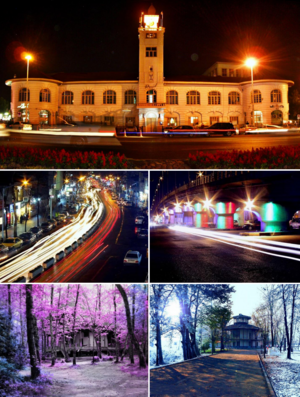Resht
|
Rašt Rəsht |
|
|---|---|
| City | |
 |
|
| Nickname(s): Rain City, Rasht-Heaven | |
| Coordinates: 37°16′51″N 49°34′59″E / 37.28083°N 49.58306°ECoordinates: 37°16′51″N 49°34′59″E / 37.28083°N 49.58306°E | |
| Country |
|
| Province | Gilan |
| County | Rasht |
| Bakhsh | Central |
| Area | |
| • Total | 180 km2 (70 sq mi) |
| Population (2012) | |
| • Total | 622,209 |
| • Density | 3,500/km2 (9,000/sq mi) |
| Time zone | IRST (UTC+3:30) |
| • Summer (DST) | IRDT (UTC+4:30) |
| Area code(s) | 013 |
| Website | www |
Rasht (Persian: رشت Rašt; Gilaki: Rəsht; also Romanized as Resht and Rast, and often spelt Recht in French and older German manuscripts) is the capital city of Gilan Province, Iran. As of the 24 October 2011 census, its population was 639,951.
Rasht is the largest city on Iran's Caspian Sea coast. It is a major trade center between Caucasia, Russia and Iran using the port of Bandar-e Anzali. Rasht is also a major tourist center with the resort of Masouleh in the adjacent mountains and the beaches of Caspian as some of the major attractions.
Historically, Rasht was a major transport and business center which connected Iran to Russia and Europe, and because of this was known as the "Gate of Europe". The city has a history that goes back to the 13th century but its modern history dates back to the Safavid era during which Rasht was a major silk trade center with numerous textile workshops.
For a more comprehensive treatment of the region, see the history section of Gilan.
Rasht was first mentioned in historical documents in 682 CE, but it is certainly older than this and appears on the Peutinger Map of late antiquity. It has seen the Sassanid era, the armies of Peter the Great and later Russian rulers, and British colonialism. The people of Rasht also played a major role in the Constitutional Revolution of Iran.
...
Wikipedia

